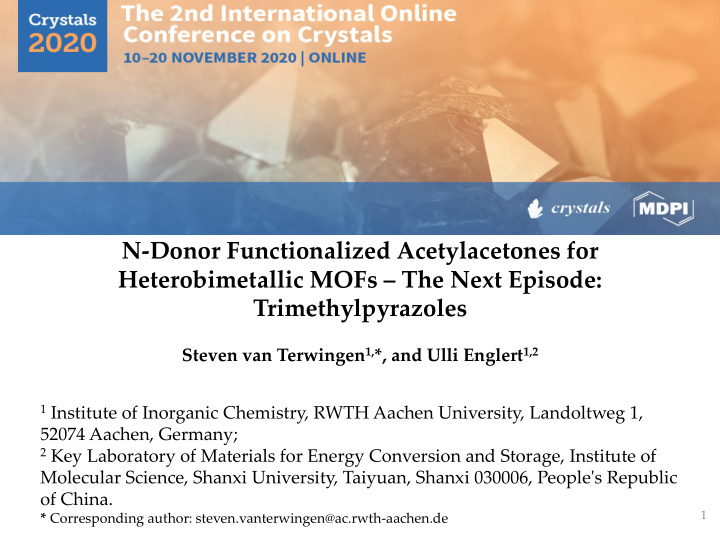



N-Donor Functionalized Acetylacetones for Heterobimetallic MOFs – The Next Episode: Trimethylpyrazoles Steven van Terwingen 1, *, and Ulli Englert 1,2 1 Institute of Inorganic Chemistry, RWTH Aachen University, Landoltweg 1, 52074 Aachen, Germany; 2 Key Laboratory of Materials for Energy Conversion and Storage, Institute of Molecular Science, Shanxi University, Taiyuan, Shanxi 030006, People's Republic of China. 1 * Corresponding author: steven.vanterwingen@ac.rwth-aachen.de
Abstract: While metal-organic frameworks (MOFs) have been investigated intensively throughout the last decades, only a fraction of the published articles on MOFs feature heterobimetallic structures. Combining two metallic centers in a rigid framework could lead to interesting effects, such as magnetic coupling, collaborating fluorescence or catalytic properties; however, its synthesis is more sophisticated than for monometallic MOFs. We utilize ditopic ligands whose coordination sites differ in their Pearson hardness (HSAB). This enables a stepwise selective formation of heterobimetallic MOFs: first, a monometallic building block is synthesized. In a second step the framework can be constructed by crosslinking with a second metal ion. In this work we present our most recent ligand candidate: 3-(1,3,5-trimethyl- 1 H -pyrazol-4-yl)acetylacetone. Its synthesis is straightforward and inexpensive. The O,O’ coordination was accomplished with a variety of hard cations like Fe III or Ga III . First crosslinking attempts with N coordination of the Fe III building block to Ag I leads to a one-dimensional coordination polymer with high porosity. Keywords: MOFs; coordination chemistry; crystal engineering 2
Introduction We aim for the stepwise and selective synthesis of heterobimetallic metal-organic frameworks (MOFs). For that purpose we utilize ditopic ligands which donor sites differ in Pearson hardness [1]. Here we present a trimethylpyrazolyl substituted acetylacetone to construct a heterobimetallic coordination polymer. H ARD Cu I , Ag I , Hg II Fe III , Ga III , Yb III [1] R. G. Pearson, J. Am. Chem. Soc. 1963 , 85 , 3533 – 3539. 3
Motivation Stepwise synthesis of a heterobimetallic MOF achieved with a ditopic ligand: building unit Ligand heterobimetallic MOF 4
Motivation There are various properties of these MOF’s which are worth investigating (bottom left). Post-modification and/or thermal decomposition can also lead to complex systems with interesting features, e.g. one example of our group shows catalytic properties for the N 2 O conversion to the elements after thermal decomposition of an Yb III /Ag I MOF (bottom right) [3]: Yb 2 O 3 Ag 0 N 2 N 2 O Analysis of the MOF‘s : O 2 • N 2 O topology[2] N 2 • catalytic properties[3] • luminescence heterogeneous solid[3] • gas storage properties • magnetism [2] M. O'Keeffe, M. A. Peskov, S. J. Ramsden, O. M. Yaghi, Accts. Chem. Res. 2008 , 41 , 1782-1789. [3] M. Konkol, M. Kondracka, P. Kowalik, W. Próchniak, K. Michalska, A. Schwedt, C. Merkens, U. Englert, Appl. Catal., B 2016 , 190 , 85-92.
Results – Synthesis Crosslinking with Fe III /Ag I leads to a 1D polymer 1 : 1. Fe(NO 3 ) 3 Ag 2. AgClO 4 MeCN Fe Fe composition C 560 H 768 Ag 16 Fe 16 N 112 O 96 Crystal system orthorhombic Space Group Fdd 2 Ag a / Å 53.3047(8) b / Å 70.5917(12) c / Å 15.1465(3) V / Å 56994.3(17) Z 2 θ min/max (Cu-K α ) 2.08/58.2 total/unique/observed refl. 144676/19245/10675 R 1 [ I > 2 σ ( I )] 12.92 % 1 w R 2 [all data] 22.75 % S 0.962
Results – Topology The chain polymer propagates in a wave-like fashion: View from the ab plane: n The chains exhibit ligands as crosslinkers between two strands, forming a ladder-like chain: View from the ac plane:
Results – Topology a c The polymer propagates in [1 0 1] direction. Three different strands are depicted on the right. The point symbol for this coordination polymer is 4 1 .4 1 .6 1 .
Results – Topology simplified representation of the 1D polymer: There are no meaningful = interactions between two of the ladder-like chains. The shortest distance between them amounts to 2.7 Å: 2.7 Å
Results – Topology There are huge solvent accessible voids in the structure. The PLATON SQUEEZE [4,5] procedure was used to determine size and electron count of the voids: Cell volume / Å 3 56994.3(17) b Void volume / Å 3 30200 percent void of cell 53.1 % electron count 9600 a packing index 67.4 % electron count − 32 ClO 4 − 8250 amount* of MeCN/H 2 O 260 Volume* per Atom / Å 3 25 [4] A. L. Spek, Acta Crystallogr. 2009 , D65 , 148 – 155. [5] A. L. Spek, Acta Crystallogr. 2015 , C71 , 9 – 18. * assuming 32 e − and 80 Å 3 per MeCN/H 2 O pair
Conclusions The potential of the novel ligand featuring a pyrazolyl group shows promising results for the stepwise synthesis of heterobimetallic MOFs. The coordination polymer with Fe III /Ag I shows large solvent-filled voids, created by the wave-like propagation of the one-dimensional chains in [1 0 1] direction. Further investigation of the properties is planned. Thermal decomposition and, afterwards, screening for catalytic properties will be performed. The anion of the Ag I salt will be altered, to investigate ist effects on the related structure. Also, the choice of different metals, e.g. Cu II , could lead to interesting effects and different topologies. If you have any questions please do not hesitate to write me an e-mail: steven.vanterwingen@ac.rwth-aachen.de
Acknowledgements An RWTH fellowship to SvT is gratefully acknowledged. The help of all members of the AKS and the Institute of Inorganic Chemistry, RWTH Aachen University is greatly appreciated.
Recommend
More recommend